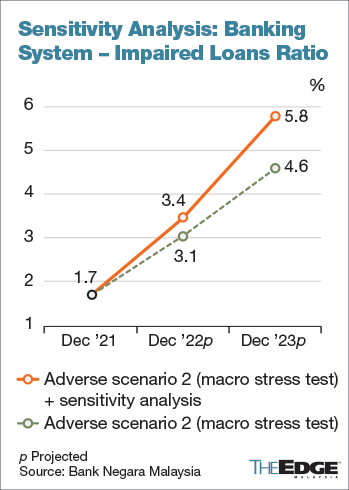
KUALA LUMPUR (Oct 5): Gross impaired loan (GIL) ratio of the banking system inched higher to 1.8% in June 2022 from 1.7% in June 2021, on the back of an increase in GIL ratio for both business and household sectors, Bank Negara Malaysia (BNM) data showed.
"The increase was driven by a small number of vulnerable household and SME (small and medium enterprise) borrowers who were unable to resume loan repayments after exiting repayment assistance programmes and defaults of specific corporate borrowers," BNM said in its Financial Stability Review for the first half of 2022.
The banking system's GIL ratio averaged at 1.6% in 2015-2019, BNM said.
Among businesses, GIL of the banking system loans edged up to 3% for the business sector as of June 2022 versus 2.8% at end-December 2021, fuelled by certain borrowers who faced challenges in servicing their debt obligations after exiting repayment assistance.
"The uptick was driven mainly by borrowers in the construction, mining and quarrying, and wholesale and retail trade sectors," BNM said.
The business sector GIL ratio has been on the rise from 2.5% in June 2020, based on data showed in the Financial Stability Review.
However, BNM said impairments should be relatively contained based on leading indicators from banks. It cited that the share of business loans with credit risk declined to 14.4% in June 2022, from 16.2% in December 2021, in line with the gradual improvement in business conditions.
Meanwhile, household GIL ratio also inched upwards to 1.2% of the banking system loans for that sector, from 1.1% in December 2021, having remained unchanged since December 2020.
Across both business and household sectors, the vast majority of borrowers who exited repayment assistance programmes, however, have resumed servicing their loans, BNM said.
BNM said while higher interest rates and cost of living could see defaults rise further for some borrowers in the second half of 2022, the increase in overall impairments is expected to be modest given improving economic growth prospects and labour market conditions.
Under an adverse scenario sensitivity analysis on the banking system which includes the ringgit performing worse than during the 1998 Asian financial crisis, BNM said overall impairments could rise to 5.8% by end-2023, as opposed to 4.6% under a macro solvency stress test.
The relatively modest incremental impairments were "mainly attributed to additional defaults by household borrowers (about 75% share of the additional impairments) with more limited financial buffers to cope with higher cost of living and borrowing costs, and SME borrowers from the construction, and hotels and restaurants sectors", it said.
"Nonetheless, the banking system's capital ratios remained well above the regulatory minima post-shock at 15.4% as at end-2023," it added.


